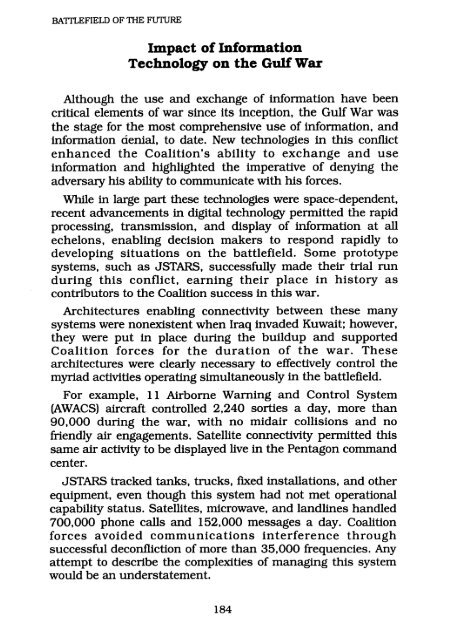BATTLEFIELD OF THE FUTURE
Battlefield of the Future - Air University Press
Battlefield of the Future - Air University Press
Create successful ePaper yourself
Turn your PDF publications into a flip-book with our unique Google optimized e-Paper software.
<strong>BATTLEFIELD</strong> <strong>OF</strong> <strong>THE</strong> <strong>FUTURE</strong><br />
Impact of Information<br />
Technology on the Gulf War<br />
Although the use and exchange of information have been<br />
critical elements of war since its inception, the Gulf War was<br />
the stage for the most comprehensive use of information, and<br />
information denial, to date . New technologies in this conflict<br />
enhanced the Coalition's ability to exchange and use<br />
information and highlighted the imperative of denying the<br />
adversary his ability to communicate with his forces .<br />
While in large part these technologies were space-dependent,<br />
recent advancements in digital technology permitted the rapid<br />
processing, transmission, and display of information at all<br />
echelons, enabling decision makers to respond rapidly to<br />
developing situations on the battlefield . Some prototype<br />
systems, such as JSTARS, successfully made their trial run<br />
during this conflict, earning their place in history as<br />
contributors to the Coalition success in this war .<br />
Architectures enabling connectivity between these many<br />
systems were nonexistent when Iraq invaded Kuwait ; however,<br />
they were put in place during the buildup and supported<br />
Coalition forces for the duration of the war . These<br />
architectures were clearly necessary to effectively control the<br />
myriad activities operating simultaneously in the battlefield .<br />
For example, 11 Airborne Warning and Control System<br />
(AWACS) aircraft controlled 2,240 sorties a day, more than<br />
90,000 during the war, with no midair collisions and no<br />
friendly air engagements . Satellite connectivity permitted this<br />
same air activity to be displayed live in the Pentagon command<br />
center .<br />
JSTARS tracked tanks, trucks, fixed installations, and other<br />
equipment, even though this system had not met operational<br />
capability status . Satellites, microwave, and landlines handled<br />
700,000 phone calls and 152,000 messages a day. Coalition<br />
forces avoided communications interference through<br />
successful deconfliction of more than 35,000 frequencies . Any<br />
attempt to describe the complexities of managing this system<br />
would be an understatement .<br />
184

















